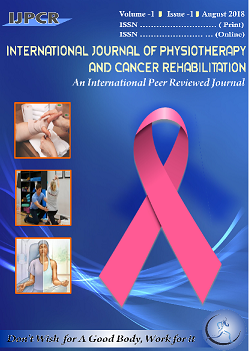International Journal of Physiotherapy and Cancer Rehabilitation
SEARCH
Our Founder
Popurlaly known as ‘jannu bhai’, the Late manishi’s vision, farsightedness and sacrifice have enabled us reach the stature we enjoy today More...Vice Chancellor's Message
It gives me immense pleasure to learn that the 1st volume of international journal of physiotherapy and cancer rehabilitation is being More...Cover Page Volume I Issue I
 .
.
IJPCR
EXERCISE REHABILITATION IN BREAST CANCER
Dr. Smriti Neha
Abstract:
EXERCISE REHABILITATION IN BREAST CANCER
Breast cancer is the most common cancer in women worldwide, and the probability of an arbitrary woman being diagnosed with breast cancer during her lifetime is about 10-13%. (1); among these women, 38% were diagnosed more than 10 years ago. Because of its high incidence and relatively good prognosis, breast cancer is the most prevalent cancer among women in the world. However, breast cancer is still the leading cause of cancer-related death among women in many developed countries, and is the most common cause of death of women aged 40–60 years (1). Breast cancer mortality rates have declined, possibly due to earlier detection, improvements in surgical resection, radiation, and systemic therapies (2). Thus, as more patients survive breast cancer, the number of women living with long-term side effects also increases (2).
CLINICAL PRACTICE
Today, three screening tests are routinely in use for detection of breast cancer: mammography, physical breast exam, and breast self-exam. When a breast tumor is detected, a more detailed examination can be done (mammogram and/or ultrasound and/or MRI (Magnetic Resonance Imaging). The final diagnosis is performed by microscopic examination of fine-needle aspirations (cytology) or a biopsy (histology) (3). Even though the routines related to breast cancer diagnosis are efficient, patients may have to wait several weeks before treatment. This delay waiting period may impose additional psychological challenges for the woman.
Treatment options of breast cancer patients and morbidities.
Breast cancer treatment involves multiple medical disciplines. The treatment depends on the patients age, menopausal status as well as disease stage and pathological features; type, tumor grade, multifocal receptor status, and family predisposition (3). Disease stage is determined by tumor size, the number and location of lymph nodes involved, and the presence or absence of distant metastatic disease. The treatment consists of local treatments such as surgery and radiotherapy, systemic treatment such as chemo and hormone therapy, and monoclonal antibodies (4;5).
Surgery
Surgical procedures have been modified during the last decades (6). With radical mastectomy (Halsteds method), major side effects occurred (extensive and frequent arm and shoulder morbidities). It was therefore replaced by modified radical mastectomy in the 1970-80’s. Postsurgical side effects were reduced without increase in local relapses or decreased survival rates. Breast conserving treatment was then developed. Randomized studies showed that only removing the tumour (lumpectomy) and a rim of normal surrounding breast tissue were as safe as modified radical treatment, if the patient was treated with postoperative radiotherapy to the whole breast (7;8). Axillary lymph node dissection (ALND) is now done in less than 50 % of the patients due to sentinel lymph node biopsy (SLNB) (9;10). The status of the axilla is one of the most important prognostic factors in breast cancer. Subsequent decisions on supplementary treatment depend on how much lymph nodes are affected as well as other patient and tumour characteristics. Mastectomy is still recommended for patients with large tumours and for patients when irradiation is contraindicated. Other factors may need to be taken into account as well when consider mastectomy (e.g. genetic factors and high risk of relapse) (3). For these patients, breast reconstruction can be performed concomitantly with mastectomy or at a later time.